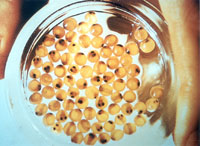Fish Culture
Natural Life
 Trout eggs are deposited in prepared redds, or nests in the gravel of stream beds and hatch in 4 weeks or more. A young fish or fry lives for 3 to 4 weeks on food absorbed from the yolk sac. Once the yolk is absorbed, the fry emerges from the gravel and feeds on microscopic aquatic organisms. From the many eggs deposited in the gravel, only a few fish survive to adulthood. Some are killed by contaminants in polluted runoff water, siltation caused by development too close to streams or increased water temperature resulting from impoundments and forest canopy clearing. Many die from natural causes such as floods, drought or predators. Even under ideal natural conditions, relatively few trout will reach a catchable size to be taken by fishermen.
Trout eggs are deposited in prepared redds, or nests in the gravel of stream beds and hatch in 4 weeks or more. A young fish or fry lives for 3 to 4 weeks on food absorbed from the yolk sac. Once the yolk is absorbed, the fry emerges from the gravel and feeds on microscopic aquatic organisms. From the many eggs deposited in the gravel, only a few fish survive to adulthood. Some are killed by contaminants in polluted runoff water, siltation caused by development too close to streams or increased water temperature resulting from impoundments and forest canopy clearing. Many die from natural causes such as floods, drought or predators. Even under ideal natural conditions, relatively few trout will reach a catchable size to be taken by fishermen.
Trout Stocking
Three species of trout are raised at the Walhalla State Fish Hatchery - Rainbow, Brook and Brown trout. Most of these fish are stocked at a catchable size into streams of South Carolina. The state has limited numbers of streams cold enough to support trout on a year-round basis. Suitable coldwater streams are generally restricted to higher elevations in Greenville, Pickens, and Oconee counties. Please visit our kiosk (Item Number 7 above) for a list and map of streams that are stocked with fingerlings or with catchable size trout. Most of these fish are stocked by truck at a 9 inch size about 200,000 annually. A smaller number about 30,000 are stocked at a 12 inch size or larger. Some of the smaller streams are stocked only with 3 to 5 inch fingerlings. Also, the more remote sections of the Chattooga River are stocked by helicopter with 25,000 five inch fingerlings. Trout stocked at these smaller sizes convert to natural food for continued growth.
The stocking season typically begins in mid-February and goes through mid-November. During July and August some of the lower elevation streams are not stocked because water temperatures get too high.
Trout Culture
Trout broodstock (parent fish) are main- tained at the hatchery and the eggs are taken manually when the fish become “ripe” in October or November. The eggs taken from the females are fertilized with milt (sperm) from the males. The eggs are then placed in special incubators where they receive a continuous supply of oxygen-rich water. At the early stage, the eggs are very tender and cannot be handled. Total incubation time, from spawning to hatch, is normally 4 to 6 weeks.
About half way through the incubation period, the eyes of the developing embryo can be clearly seen through the transparent shell. This is called the "eyed" stage. At this time they can be handled and transported without harm to the fish.
After hatching, the small fry have their own food supply in the form of a yolk sac which is still attached and clearly visible. This is the young fish’s only food source for the first two or three weeks of life. The yolk sac is gradually absorbed and the fish are then ready to begin feeding.
The trout are fed a commercially prepared food that is granular in size for the small fish while different size pellets are given to the larger fish. This food is high in protein and other nutrients and provides a complete diet.
The small trout are kept inside the hatchery building until they reach about 2 inches in length. They are then moved to the outside raceways for continued growth. It takes 14 to 16 months for the fish to reach the stocking size of 9 inches.